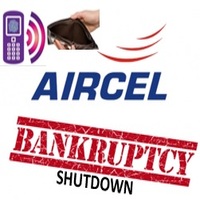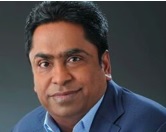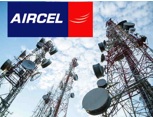Why did Aircel Company get Bankrupt ? Aircel Shutdown – दिवालिया क्यों

Aircel Background
Aircel is an Indian Mobile Network Operator. Its headquarter is in Gurugram. It offers voice and 2G, 3G data service. Maxis Communications holds its 74% stake. Aircel was founded by Chinnakannan Sivasankaran and commenced operations in Tamil Nadu in 1999.

Aircel Founder Chinnakannan Sivasankaran
- It is sixth largest mobile service provider in India with a subscriber base of 84.39 million subscribers as of December 2017.
- Aircel is a market leader in Tamil Nadu and has considerable presence in Odisha, Assam and North-East telecom circles.
- Telecom subscriber base – 118 crore (End of November 2017, TRAI Report)
- Bharti Airtel – Number 1 – 29 crore.
- Jio – Number 2 – Fast Growing
- Aircel – Number 6 – 8 crore
Top Five Wireless Broadband Service Providers
As on November 30, 2017, the top five wireless broadband service providers were
- Reliance Jio Infocomm (15.2 crore subscribers)
- Bharti Airtel (6.72 crore)
- Vodafone (5 crore)
- Idea Cellular (3.29 crore)
- BSNL (1.19 crore)
Aircel along with its units – Aircel Cellular and Dishnet Wireless filed for bankruptcy in the National Companies Law Tribunal (NCLT) in Mumbai due to fierce competition and high levels of debt (approx 15000 crore).
This is the fourth telecom firm to wind up after billionaire Mukesh Ambani led Reliance Jio debuted in September 2016, unleashing a disruptive price war in the sector with its free voice calls and dirt-cheap data.
Norway-based Telenor is transferring its assets to Airtel.
Wireless business of Tata Teleservices is also transferring its assets to Airtel.
Anil Ambani-run Reliance Communications, which is reeling under a debt of around Rs 42,000 crore, is bowling out of the business with Jio set to acquire its wireless infrastructure assets.
Aircel has been bankrupt due to the following reasons
- Intense Competition following the disruptive entry of a new player i.e. Jio.
- Legal and regulatory challenges
- High level of unsustainable debt
- Increased losses had together caused significant negative business and reputational impact on the company.
The Telecom Regulatory Authority of India (TRAI) cut Interconnection Usage Charge (IUC) levied by telecom firms by 57%(In October, 2017). This is a big win for Reliance Jio Infocomm Ltd.
Interconnection Usage Charge (IUC)
- Interconnection means the arrangement whereby the telecom payers are able to connect their equipment, networks and services with other telecom players to provide services to end users. IUC is defined by TRAI under a specific formula.
- The charge is paid by the service provider whose subscriber originates the call to the service provider in whose the call is made. Thus, if I am an airtel subscriber and call Geeta, a Jio subscriber; then I will pay to airtel and airtel will need to pay the IUC to Jio.
- In simple term, IUC charge is that Jio will pay the charge to Airtel Company if Jio is using Airtel Tower i.e. Tower Sharing.
- The objective of this calling-party pays regime (CPP) is to allow operators cover network usage costs. Since it needs infrastructure investment, the IUC ensures that operators make enough operations to keep their business viable.
- Till 2003, the subscribers had to pay for both incoming and outgoing calls. That year paved the way for a Calling Party Pays (CPP) regime and subscriber no longer needed to pay for incoming calls. This made mobile phone highly affordable to the low usage customers who mainly used it for incoming calls. But still, the outgoing calls are charged under this regime.
- This makes it possible to allow seamless connections and is one of the major revenues of the telecom operators. There are several components of IUC such as termination charge, transit charges, international settlement rates, carriage charges.
- The current issues are only about the termination charge component. At present, only wireless to wireless attract IUC.
Stance of Companies
- The stance of the companies depends on which kind of their infrastructure is. The existing players such as Bharti Airtel, Idea, Vodaphone etc. have most of their network on 2G. The costs on 2G are higher so they wanted to hike or at least a status quo in IUC.
- However, Jio supported either reducing or even ending the IUC. The reason is two-fold. First, most of network of Jio is on 4G which costs less.
- Second, since Jio has offered free calls, most of calls made on its network are originating instead of terminating, thus, its IUC bill is substantially low.
- Prior to recent move, TRAI had reduced IUC from 30 paise per minute to 14 paise in 2014.
Aircel Cellular Ltd. has filled for bankruptcy under Insolvency and Bankruptcy Code, 2016.
Aircel has more than 85 million subscribers across 17 telecom circles, in India.
Aircel service were disrupted after Telecoms like Idea Cellular and Vodafone stopped interconnect services for non-payment of dues.
While the operator had shut services in six circles, services in other regions were hit due to financial problems. GTL Infrastructure had switched off nearly one-third of the total towers due to non-payment of dues.
On January 25, 2018, Aircel went into a strategic debt restructuring programme with its lenders.
Yet, just a few days later, the Reserve Bank of India (RBI) came out with stiff new rules under which existing SDRs had to be resolved within six months or be referred to the NCLT.
Krishan and Maxis, who had in their talks with bankers, promised to bring in $250 million as fresh equity into the company, were stumped with new rule and decided to call it a day.
How will the new framework look like?
- The new framework will subsume most of the existing stressed asset schemes such as the Strategic Debt Restructuring Scheme (SDR) and the scheme for Sustainable Structuring of Stressed Assets (S4A), Corporate Debt Restructuring Scheme.
- It would give primacy to the Insolvency and Bankruptcy Code (IBC) of 2016.
- It will also disband the concept of a Joint Lenders’ Forum (JLF), which is a dedicated grouping of lender banks that is formed to speed up decisions when an asset (loan) of Rs. 100 crore or more turns out to be a stressed asset.
- The banks are supposed to categorise them as special mention accounts, report to the RBI and start the resolution process straight away.
- The SMA(Special Mention Account) sub-categories are classified as principal or interest payment or any other amount wholly or partly overdue between 1-30 days as SMA-0, between 31 – 60 days as SMA-1 and between 61 – 90 days as SMA-2.
Aircel currently has a debt of Rs. 150 billion.
The problem was simple : with Aircel incurring losses of Rs 1 – 1.5 billion every month.
Yet analysts say that its asset sale which include 2G and 3G spectrum – It has already sold its 4G spectrum to Airtel — is surely not going to fetch much money for its lenders, especially as most of their subscribers are in 2G.
And there are vendors like American Tower Corporation which have already gone to court to get their dues paid. Aircel’s future would have been different had the merger with Rcom fructified.
The merger entity, which was to be called Aircom (merger of Aircel & Reliance Communication)and in which it would have had 50 % stake, would have surely been a competitive fourth player in the market with a 15 % market share. That’s pretty close to share enjoyed by Idea Cellular.
The deal would also have helped Aircel to reduce its debt substantially by over rs 140 billion, leaving only a small portion of its loans to service. But with fears that because of the various cases against the company, the department of telecommunications would not give the green signal for its merger, RCom decide to pull out.
Aircel Scam
- In 2011, the Airtel-Maxis deal came under the scanner after Sivasankaran lodged a complaint that he was coerced into selling his company to Maxis.
- It was alleged that the Maxis Group had invested in Sun Direct between 2007 and 2009 and Dayanidhi Maran as the Telecom Minister misused office in the deal. It was also alleged that Maxis made a quid pro quo investment in Sun Direct TV, owned by Dayanidhi’s brother, Kalanithi Maran.
- The finance minister Chidambaram was also alleged of delaying the clearance till son received shares in Aircel.
- In 2014, the CBI filed charge sheet against former Telecom Minister Dayanidhi Maran and his brother Kalanidhi Maran; T. Ananda Krishanan and Ralph Marshall, a senior executive of the Maxis Group.
- In 2015, the CBI told a special court that Malaysian authorities were not cooperating in the service of summons.
- In August 2016, the CBI moved court for issuance of warrants against Ralph Marshall and Ananda Krishnan as they failed to appear before the agency.
- In September 2016, Reliance Communication and Aircel announced a merger deal with equal representation on the board.
Maxis was not ready to fund it for the next six months during which the SDR talks would go on.
This even though the lenders had agreed to convert their debt into equity.
The company has now reconstituted the board and has decided for the bankruptcy proceedings in the NCLT after its two attempts to revive its fortunes did not take off.
Despite this, Aircel made yet another attempt to survive in the face of an onslaught in the telecom sector from Jio. The company decided to prune its operations and concentrate on only those circles where it is strong and which have scope for growth as a niche player.
So on January 31, Aircel shut its operations in six circles and concentrated on the remaining sixteen.
Note : The Telecom Regulatory Authority of India (TRAI) has directed Aircel to generate Unique Porting Codes (UPCs) in operational circles where a large number of its subscribers were facing difficulties in porting their mobile numbers.
Telecom Sector
- The sector has been under pressure since 2009. High financial leverage caused by rising capex- the industry has a cumulative debt of around Rs 4.6 trillion, while revenues are under Rs 1.8 trillion and increasingly thin margins thanks to Jio’s pricing strategies mean there is a long way to go.
- If 2018 is indeed to be the year of growth, much will depend on the new National Telecom Policy, the relief package the government is putting together and the big three’s ability to find new revenue streams such as financial payments and r=streaming services.
How to port your Aircel Number ?
- Send PORT YOUR 10 DIGIT Number to 1900. For example if your number is 9xxx9xxx9x, the message will be PORT 9xxx9xxx9x.
- A pop-up will confirm your decision to port. In a few minutes, you will receive a Unique Port Code (UPC).
- Save this number for future correspondence. Visit the nearest outlets of Aircel, Idea, Vodafone, Reliance Jio, BSNL or MTNL (according to your choice), and choose a service that allows porting.
- You will be asked your address proof, ID-card proof and the UPC. Once you have provided these, you can start unsing new SIM and Services.
All the best for your upcoming exam!
You can join or visit at Facebook Page or Twitter for always keep in touch with further updates.
Read more Articles…
